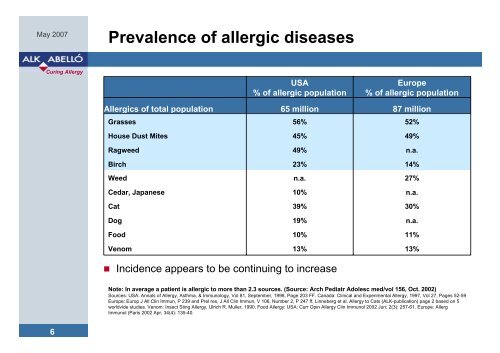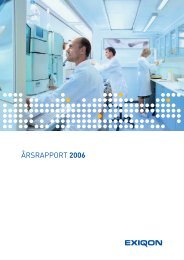(I) GRAZAX - ProInvestor
(I) GRAZAX - ProInvestor
(I) GRAZAX - ProInvestor
Create successful ePaper yourself
Turn your PDF publications into a flip-book with our unique Google optimized e-Paper software.
May 2007 Prevalence of allergic diseases<br />
Curing Allergy<br />
6<br />
Allergics of total population<br />
Grasses<br />
House Dust Mites<br />
Ragweed<br />
Birch<br />
Weed<br />
Cedar, Japanese<br />
Cat<br />
Dog<br />
Food<br />
Venom<br />
USA<br />
% of allergic population<br />
65 million<br />
56%<br />
45%<br />
49%<br />
23%<br />
n.a.<br />
10%<br />
39%<br />
19%<br />
10%<br />
13%<br />
Incidence appears to be continuing to increase<br />
Europe<br />
% of allergic population<br />
87 million<br />
Note: In average a patient is allergic to more than 2.3 sources. (Source: Arch Pediatr Adolesc med/vol 156, Oct. 2002)<br />
Sources: USA: Annals of Allergy, Asthma, & Immunology, Vol 81, September, 1998, Page 203 FF. Canada: Clinical and Experimental Allergy, 1997, Vol 27, Pages 52-59<br />
Europe: Europ J All Clin Immun, P 239 and Prel res, J All Clin Immun, V 106, Number 2, P 247 ff, Linneberg et al. Allergy to Cats (ALK-publication) page 2 based on 5<br />
worldvide studies. Venom: Insect Sting Allergy, Ulrich R. Muller, 1990. Food Allergy: USA: Curr Opin Allergy Clin Immunol 2002 Jun; 2(3): 257-61. Europe: Allerg<br />
Immunol (Paris 2002 Apr; 34(4): 135-40.<br />
52%<br />
49%<br />
n.a.<br />
14%<br />
27%<br />
n.a.<br />
30%<br />
n.a.<br />
11%<br />
13%




